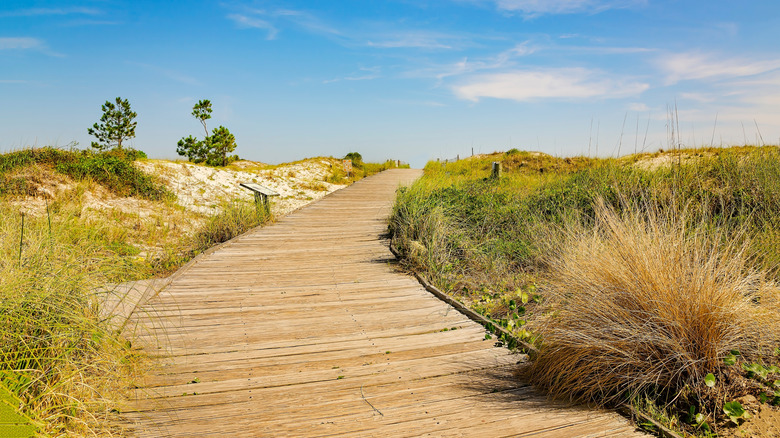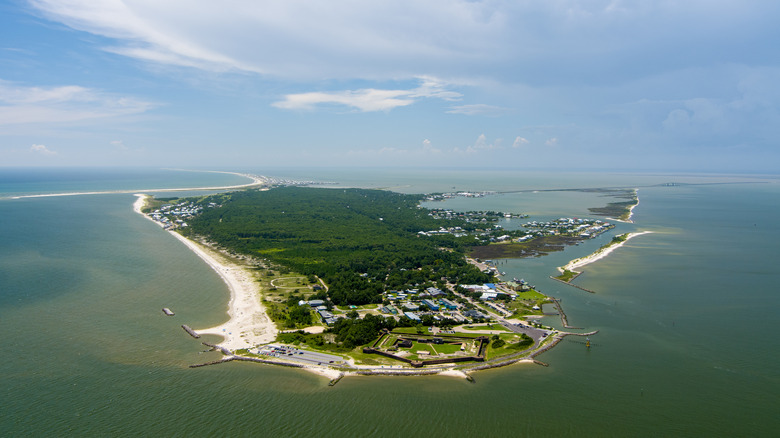One Of The World's Newest Beaches Is An Uncrowded, Walkable Alabama Gem That May Disappear In The Next Decade
Every once in a while, Mother Nature plays a game of peek-a-boo, creating a rare glimpse of its might and beauty while reminding us of the world's ever-temporary state. Things like Halley's Comet, double rainbows, or two yolks in a single egg. Alabama's experiencing a similarly fleeting phenomenon — a new beach, formed by shifting sands, that is already vanishing. The resulting walkable gem connects notably affordable Dauphin Island's western end to a barrier island a mile from its shores called Pelican Island. Plan your trip soon. This unmapped and uncrowded slab of white sand, dubbed Pelican Peninsula, will most likely disappear in the next decade.
The ephemeral nature of the island has confounded the U.S. Army Corps of Engineers, which has sought ways to stop Dauphin Island's east end from eroding. Yet it also serves the local ecosystem. The massive collection of sand in Pelican Peninsula will disperse north, replenishing Dauphin's beaches. The sheer quantity of moving grains may be hard to grasp. Consider this — what was once a fishing pier just north of Pelican Island has become the longest beach boardwalk in Alabama, thanks to the peninsula's slow erosion.
See a beach no one else will
You won't find Pelican Peninsula on old maps. The beach was born from an ever-morphing barrier island a mile out from Dauphin Island. The current version of Pelican Peninsula showed up several years ago, part of a distinct geological dance that shifts about sand and sediment. The island's location, shape, and size change. Tides, currents, and hurricanes all manhandle the malleable little isle. Eventually, the tumult caused Pelican Island to weld onto Dauphin Island, creating the temporary peninsula that is a seaside paradise. Nature has pulled this same party trick twice before in recorded history: in the early 1700s and then in 1852.
The beach's novelty makes it that rarest of gems — an under-discovered waterfront property. Civilization cannot exist where nature itself refuses to linger. Developers cannot slice and dice it into parcels for real estate deals. Instead, driftwood and seashells safely dot its white, sandy shores. The lack of other people makes the chorus of lapping waves and cawing gulls seem louder, yet more soothing. A dolphin sighting can happen while pelicans and ospreys dot the sky. It's all made even more valuable by its looming demise.
The geologic witchcraft that created Pelican Peninsula occurs once every 150 years. After you, your great-grandkids will most likely see it again, though in a slightly different configuration and form. In fact, the stretch of sand continues to morph like goo in a lava lamp. Every storm, wind, and surge warps its shape. The Pelican Peninsula you visit may disappear within days and be replaced by another version.
Planning your trip to Pelican Peninsula
Unless you're within driving distance, you'll have to fly to Mobile Regional Airport to reach Dauphin Island and then Pelican Peninsula. About 38 miles away, you'll need around 50 minutes to reach the island by car. Be sure to check out the scenic Alabama Coastal Connection Scenic Byway, an underrated road that connects seaside towns and beaches. Along the way, stop at Heron Bay, a hidden Gulf Coast haven with fresh seafood and tranquility. Dauphin Island offers several accommodation options, from inns to motels and hotels, costing up to $300 a night, depending on your visit.
Given the peninsula's temporary nature, your best bet is to visit... now. Or as soon as possible. While it may not disappear overnight, Pelican Peninsula's fate is more or less sealed. Birdwatchers should bring binoculars. Migratory birds use the area as a stopover, mixing with the already-diverse local feathered friends. Check the tide forecast before your visit, as low tide naturally increases the peninsula's size and creates sandbars. Pack sunscreen and bottled water; shade is scarce.


